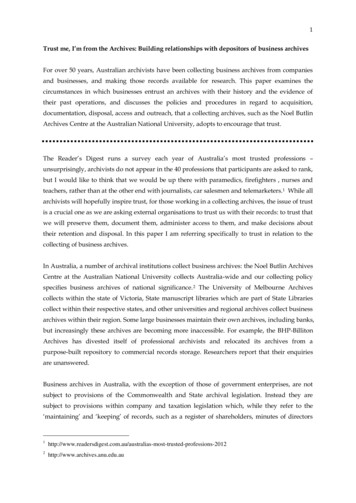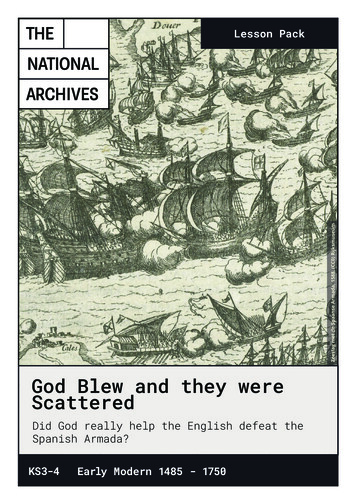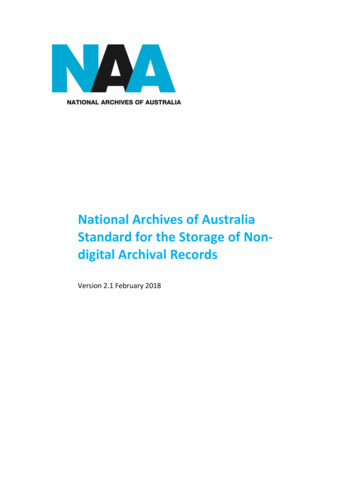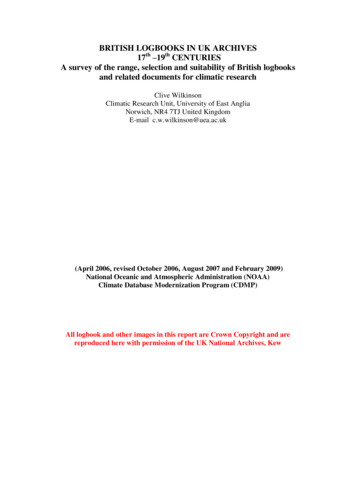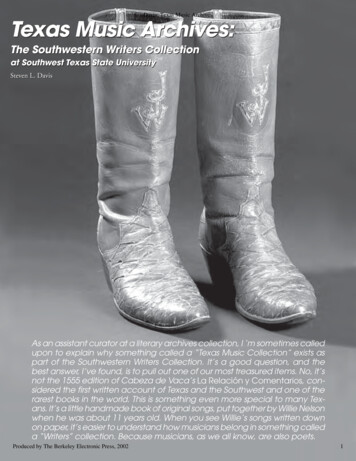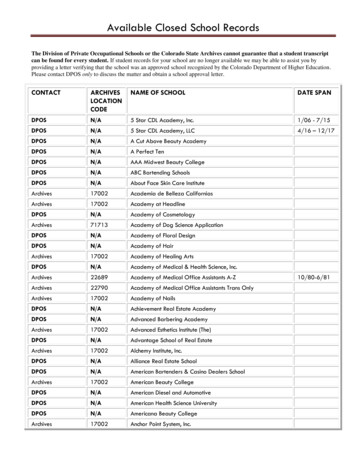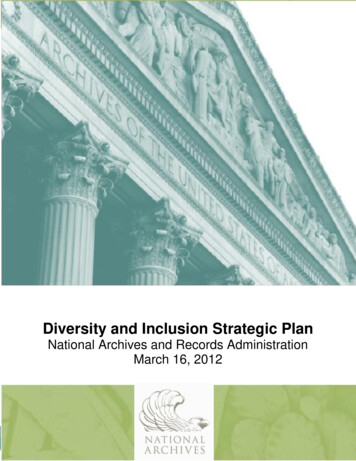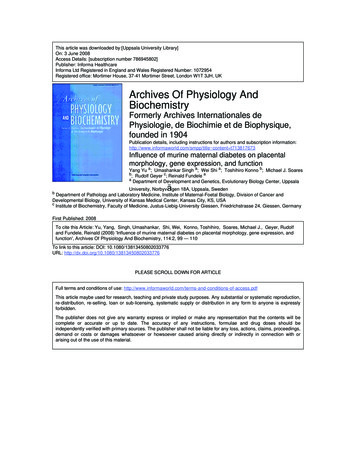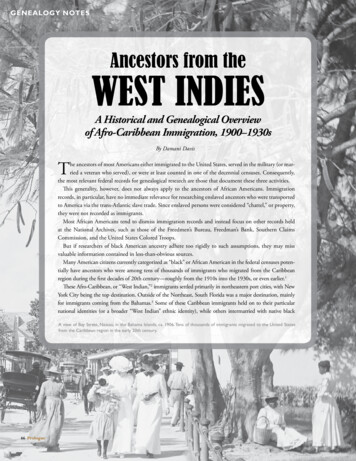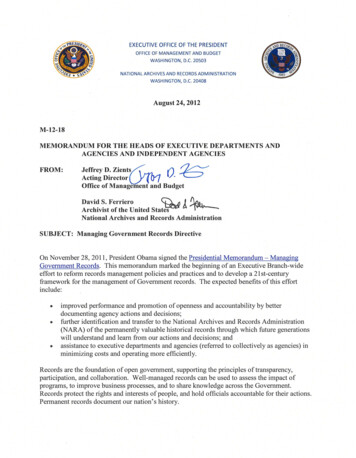
Transcription
EXECUTIVE OFFICE OF THE PRESIDENTOFFICE OF MANAGEMENT AND BUDGETWASHINGTON, D.C. 20503NATIONAL ARCHIVES AND RECORDS ADMINISTRATIONWASHINGTON, D.C. 20408August 24, 2012M-12-18MEMORANDUM FOR THE HEADS OF EXECUTIVE DEPARTMENTS ANDAGENCIES AND INDEPENDENT AGENCIESFROM:0Jeffrey D. Zients .v1 Acting DirectorOffice of Management and BudgetLY (01. .David S. Ferriero ! Archivist of the United States National Archives and Records AdministrationSUBJECT: Managing Government Records DirectiveOn November 28, 2011, President Obama signed the Presidential Memorandum - ManagingGovernment Records. This memorandum marked the beginning of an Executive Branch-wideeffort to reform records management policies and practices and to develop a 21st-centuryframework for the management of Government records. The expected benefits of this effortinclude: improved performance and promotion of openness and accountability by betterdocumenting agency actions and decisions;further identification and transfer to the National Archives and Records Administration(NARA) of the permanently valuable historical records through which future generationswill understand and learn from our actions and decisions; andassistance to executive departments and agencies (referred to collectively as agencies) inminimizing costs and operating more efficiently.Records are the foundation of open government, supporting the principles of transparency,participation, and collaboration. Well-managed records can be used to assess the impact ofprograms, to improve business processes, and to share knowledge across the Government.Records protect the rights and interests of people, and hold officials accountable for their actions.Permanent records document our nation' s history.
This Directive creates a robust records management framework that complies with statutes andregulations to achieve the benefits outlined in the Presidential Memorandum. This Directive wasinformed by agency reports submitted pursuant to Sec. 2 (b) of the Presidential Memorandumand feedback from consultations with agencies, interagency groups, and public stakeholders.This Directive requires that to the fullest extent possible, agencies eliminate paper and useelectronic recordkeeping. It is applicable to all executive agencies and to all records, withoutregard to security classification or any other restriction.This Directive also identifies specific actions that will be taken by NARA, the Office ofManagement and Budget (OMB) , and the Office of Personnel Management (OPM) to suppOliagency records management programs. In addition, NARA will undertake a review to updaterelevant portions of the Code of Federal Regulations to take into account the provisions of thisDirective.Attachment2
Part I.Federal agencies shall work toward two central goals.Goal 1: Require Electronic Recordkeeping to Ensure Transparency, Efficiency, andAccountabilityTo promote openness and accountability and reduce costs in the long term, the FederalGovernment should commit immediately to the transition to a digital government. Agenciesmust meet the following targets:1.1By 2019, Federal agencies will manage all permanent electronic records in anelectronic formatBy December 31,2019, all permanent electronic records in Federal agencies will bemanaged electronically to the fullest extent possible for eventual transfer andaccessioning by NARA in an electronic format. By December 31,2013, each agencywill develop and begin to implement plans to achieve this transition. Agencies shouldalso consider the benefits of digitizing permanent records created in hard-copy format orother analog formats (e.g., microfiche, microfilm, analog video, analog audio).1.2By 2016, Federal agencies will manage both permanent and temporary emailrecords in an accessible electronic formatBy December 31 , 2016, Federal agencies must manage all email records in an electronicformat. Email records must be retained in an appropriate electronic system that supportsrecords management and litigation requirements (which may include preservation-in place models) , including the capability to identify, retrieve, and retain the records for aslong as they are needed. Beginning one year after issuance of this Directive, each agencymust report annually to OMB and N ARA the status of its progress toward this goal.Goal2: Demonstrate Compliance with Federal Records Management Statutes andRegulationsThe Federal Government should commit to manage more effectively all records consistent withFederal statutes and regulations and professional standards. Agencies must meet the followingrequirements:2.1Agencies Must Designate a Senior Agency Official (SAO)The Presidential Memorandum previously required all agencies to designate a SeniorAgency Official (SAO) to oversee a review of their records management program. ThisDirective also requires agencies to designate an SAO, but with broader agency-wideresponsibilities with respect to records management. By November 15, 2012, eachagency will name it's SAO, and by November 15 th of each subsequent year, all agencieswill reaffirm or name any new SAO. The SAO is responsible for coordinating with the3
Agency Records Officer and appropriate agency officials to ensure the agency ' scompliance with records management statutes and regulations.The SAO is a senior official at the Assistant Secretary level or its equivalent who hasdirect responsibility for ensuring that the department or agency efficiently andappropriately complies with all applicable records management statutes, regulations, andNARA policy, and the requirements of this Directive. The SAO must be located withinthe organization so as to make adjustments to agency practices, personnel, and funding asmay be necessary to ensure compliance and suppOli the business needs of the departmentor agency.2.2 SAO Shall Ensure that Permanent Records are Identifiedfor Transfer andReported to NARABy December 31 , 2013 , the SAO shall ensure permanent records that have been inexistence for more than 30 years are identified for transfer and reported to NARA.2.3 Agency Records Officers Must Obtain NARA Certificate of Federal RecordsManagement TrainingBy December 31 , 2014, the designated Agency Records Officer for each agency musthold the NARA celiificate of Federal Records Management Training. New incumbentsmust possess the certificate within one year of assuming the position of Agency RecordsOfficer. Agency Records Officers are generally responsible for overseeing the day to dayagency recordkeeping requirements outlined in 36 CFR 1222.22, Subpart B.2.4 Agencies Must Establish Records Management TrainingBy December 31 , 2014, all Federal agencies must establish a method to inform allemployees of their records management responsibilities in law and policy, and developsuitable records management training for appropriate staff.2.5 SAO Shall Ensure that Records are ScheduledBy December 31 , 2016, the SAO shall work with the Agency Records Officer to ensurerecords schedules have been submitted to NARA for all existing paper and other non electronic records. To facilitate this goal , the Agency Records Officer will work withNARA to identify all unscheduled records, by December 31 , 2013. This should includeall records stored at NARA and at agencies ' records storage facilities that have not yetbeen properly scheduled.4
Part II.NARA and other agencies (OMB and OPM) will take the following actions to assistagencies in meeting the two central goals of this Directive.Section A: Require Electronic Recordkeeping to Ensure Transparency, Efficiency, andAccountabilityAlRevise NARA transfer guidance for permanent electronic recordsBy December 31 , 2013 , NARA will complete, and make available, revised guidance,including metadata requirements, for transferring permanent electronic records, toinclude additional sustainable formats commonly used to meet agency business needs.NARA will update this guidance regularly as required to stay current with technologychanges.A2Create new email guidanceBy December 31 , 2013 , NARA will issue new guidance that describes methods formanaging, disposing, and transferring email.A3Investigate and stimulate applied research in automated technologies to reduce theburden of records management responsibilitiesA3.I NARA, the Federal Chief Information Officers Council and the Fcderal RecordsCouncil will work with private industry and other stakeholders to produce economicallyviable automated records management solutions. By December 31 , 2013, NARA willproduce a comprehensive plan in collaboration with its stakeholders to describe suitableapproaches for the automated management of email, social media, and other types ofdigital record content, including advanced search techniques. The plan will detailexpected outcomes and outline potential associated risks.A3.2 By December 31 , 2014, the Federal ChiefInformation Officers Council, and theFederal Records Council, working with NARA, will obtain external involvement for thedevelopment of open source records management solutions.A4Embed records management requirements into cloud architectures and other FederalIT systems and commercially-available productsA4.I By December 31 , 2013 , NARA will incorporate into existing reportingrequirements an annual agency update on new cloud initiatives, including a description ofhow each new initiative meets Federal Records Act obligations and the goals outlined inthis Directive. For the initial report the agency will identify any existing use of cloudservices or storage, and the date of implementation.5
A4.2 By the next revision of OMB Circular A-130, OMB will update A-130 to explicitlyrequire that agencies must incorporate records management requirements when movingto cloud-based services or storage solutions.ASEvaluate the feasibility for secure "data at rest" storage and management services forFederal agency-owned electronic recordsBy December 31 ,2013, NARA will determine the feasibility of establishing a securecloud-based service to store and manage unclassified electronic records on behalf ofagencies. This basic, shared service will adhere to NARA records managementregulations and provide standards and tools to preserve records and make them accessiblewithin their originating agency until NARA performs disposition.Section B: Create a Robust Records Management Framework that DemonstratesCompliance with Federal Statutes and Regulations and Promotes PartnershipsBlThe Archivist ofthe United States will convene thefirst ofperiodic meetings of allSenior Agency OfficialsBy December 31, 2012, the Archivist of the United States will convene the first ofperiodic meetings of all SAOs to discuss progress in implementation of this Directive;agency Federal records management responsibilities; and partnerships for improvingrecords management in the Federal Government. Additionally, NARA will complete areview of all of its records management reporting requirements by December 31, 2012,and produce a report template for a single annual repOli that each SAO will send to theChief Records Officer for the U.S. Government commencing on October 1, 2013.B2Create a Community ofInterest to solve records management challengesBy December 31 , 2013, NARA, in cooperation with the Federal ChiefInformationOfficers Council, the Federal Records Council, and other Government-wide councils thatexpress interest, will establish a Community of Interest (COl) to bring together leadersfrom the information technology, legal counsel, and records management communities tosolve specific records management challenges. The COl will develop and proposeguidance, share information, create training, and identify tools that support electronicrecords management.B3Establish aformal records management occupational seriesBy December 31 ,2013 , OPM will establish a formal records management occupationalseries to elevate records management roles, responsibilities, and skill sets for agencyrecords officers and other records professionals.6
B4Continue to improve the effectiveness of Federal records management programsthrough analytical tools and enhanced NARA oversightBy December 31 , 2013 , NARA will identify a government-wide analytical tool toevaluate the effectiveness of records management programs. While continuing toconduct assessments, inspections, and studies of agency records management programs,NARA expects that a tool or similar analytical approach will help NARA and theagencies to measure program compliance more effectively, assess risks, and aid in agencydecision-making. The use of a new analytical tool in these ongoing activities wi llidentify issues that undermine effective agency records management programs as well ashighlight the best practices that will inform agency-specific or government-wideopportunities for improvement.Section C: Improve NARA Processes to Serve Agency NeedsClImprove the Current Requestfor Records Disposition Authority ProcessBy December 31 , 2015 , NARA will improve the CUlTent Request for Records DispositionAuthority process. Consistent with CUlTent Federal records management statutes, or withchanges to existing statutes (if required), N ARA will also develop criteria that agenciescan apply to the scheduling, appraisal , and overall management of temporary records thatcan be effectively monitored with appropriate NARA oversight.C2Overhaul the General Records SchedulesBy December 31 , 2017, to reduce the need for unique records schedules submitted forapproval to the Archivist, NARA, in consultation with appropriate oversight agencies,will make substantive changes to the General Records Schedules (GRS). Thesesignificant changes will include, combining the records series into more appropriateaggregations for easier disposition action by agencies, and expanding the number ofpermanent records series in the GRS to reduce the scheduling and appraisal burden onagencles.7
WASHINGTON, D.C. 20503 . NATIONAL ARCHIVES AND RECORDS ADMINISTRATION . WASHINGTON, D.C. 20408 . August 24, 2012 . M-12-18 . MEMORANDUM FOR THE HEADS OF EXECUTIVE DEPARTMENTS AND . Ferriero ! . Archivist of the United States National Archives and Records Administration . SUBJECT: Managing Government Records Directive On November 28, 2011 .
